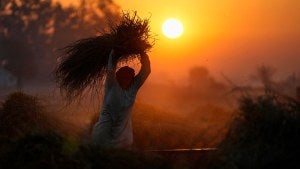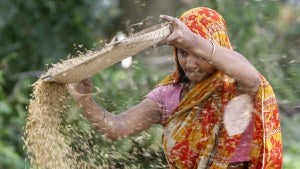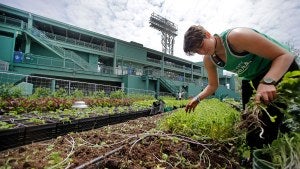Prioritizing Diversity to Ensure Resilience
 Play Podcast
Play Podcast
About the Episode
Resilience is insurance protecting the future of the food system. But what practices do farmers need to follow to create resilient systems? In this episode of Youth in Agriculture: Transforming Local Food Systems, Margaret Huang and Bram Govaerts discuss the role diversification plays in creating resilient systems, and how it intersects with gender equity.
[Intro music.
Natalie Burdsall: INTRO: Hello and welcome to the limited podcast series “Youth in Agriculture: Transforming Local Food Systems,” produced by the Chicago Council on Global Affair’s Center on Global Food and Agriculture. Today, we will be listening in on a conversation between Margaret Huang, a junior at the University of Iowa, and Bram Govaerts, Director General of the International Maize and Wheat Improvement Center, or CIMMYT.]
Margaret Huang: I'm Margaret and I am currently a junior at the University of Iowa, and I am studying public health and Spanish. And then I do have a minor in chemistry, but that is mostly just because I'm pre-med and I am planning to apply to medical school in a couple months. Last summer, I did, like, an internship with the Agricultural Research Service for the USDA. I think it was... I know it was called the... like... Wallace Carver Fellowship through the World Food Prize. And I was in New Orleans at the Southern Research... or Southern Regional Research Center, and I was looking... or I was doing a project on food sensory perception.
Bram Govaerts: So, first and foremost, thanks, Margaret, for taking the time to talk to me this morning. I know Iowa because I go there regularly for the World Food Prize almost every year. My name is Bram Govaerts. I'm originally from Belgium. I did my Ph.D... well, let's say my MSc research. I had the honor to have a scholarship from Belgium funding and did some of the research here at CIMMYT, where I'm right now in some of the long-term trials looking at agronomy, how to best plant seeds with no disruption of the soil, with leaving proper residues, crop diversification, etcetera, so conservation agriculture. Then I had the honor of doing a Ph.D., of which I did part in Ethiopia in the area where today all the conflict is happening in the northern part. Although back then, it just came out of the war between Ethiopia and Eritrea. So that was kind of a life-shaping experience but also did a lot of the research here in Mexico, and then once I finalized that research, I had the honor to take over as a postdoc from one of the renowned agronomists here. So, I was leading the agronomy team for a while, and then from there, I grew throughout the organization and was asked during COVID to take over as Director General at interim for CIMMYT, which is a huge honor because... and also, a huge weight... a weight on the shoulders because this is obviously a place that Dr. Norman Borlaug founded where he did most of... spent most of his life. If you look out of my window right now, there's a statue of Norman Borlaug right here with all the flags of our donor countries around him and the little box, little, tiny box—if you don't know, you don't notice, but that's where part of his ashes are safeguarded as there is... as it is done in India with some of the statues, or there's a statue of him also in India, and there's another one, over in... that the farmers actually requested up in the north in Mexico.
So, and now I'm just recently being confirmed to be a five-year DG, a director general, from first of July onwards. So, I will be able to drop my interim assignment from the first of July onwards. In parallel, I am an A.D. White Professor at Cornell. So that means that I have the honor to interact with young scientists, young professionals, to keep my thinking sharp. So that's kind of an additional... and I've been on the Science Advisory Board of Kellogg Company, which also has helped me to look at things from a company perspective. So, kind of, yeah, all over the spectrum. And as a professional, before being DG, I got the honor of implementing a big farmer program that's called MasAgro, “Take it to the Farmer,” where we worked with 500,000 farmers on innovations. And, also, I'm very intrigued by innovation, by social change, by transformation. Yeah, that's a bit of the story.
Margaret Huang: That’s nice to hear all of that and congratulations on your five-year appointment starting in July.
Bram Govaerts: Thank you. So, what… what gets you excited about food and agriculture? You said you had a USDA internship, so why did you decide to do it and were your expectations met?
Margaret Huang: I mostly just decided to do it because it sounded like a new, interesting experience, and I like to collect new, interesting experiences. I never think it's a bad thing to try something new or to learn something new, especially if you don't really know much about it. I had, like, gotten involved with the World Food Prize in high school because for I think, like, my junior English class, my professor was really involved with... I think she was involved with like food systems and agriculture. But she assigned this project for us to get involved in our community, and one of the options was to write a paper for the Global Food Prize. And so, I just decided to do that. And then when I went to like Iowa Youth Institute and then eventually the Global Youth Institute, which was also at Iowa State, I learned a lot about food systems and sustainability and how all of those interact in terms of global challenges and issues. And that is actually how I was introduced to public health. And so that was always... or that was just... like, ever since then it was just one of my, like, interests and like the background of, you know, everything that I'm studying in school.
And so, then I knew that they had some youth programs in college. And so, I just applied for the Wallace Carver Fellowship. And then when they reached out to me about the options, I was like, “Oh, interesting. I don't know what food sensory perceptions are.” It was talking about like what people think of food, but I didn't really know what that meant because my idea of that was... or my only experience of like food sensory perceptions was just what I had heard online about ugly produce. And how people... like they go to the grocery store, and they don't want to buy the fruits that are bruised or like they have like brown spots, and there's like a lot of food waste. And so, I thought that the research would be about that, but it was actually... the project that I was assigned to was actually about like pigmented rice, like purple ice, and red rice, and brown rice, and about like what people think of the different rice varieties. And then like it was important because like the more pigmented rices had like higher nutritional value and like the antioxidants and things like that. And so, it was really interesting. It was not quite what I expected, but I still... I feel like I got a lot out of that, not just in like learning about like the research process, and... I mean like how to design and execute an experiment. But also because I think it was just a cool experience to learn about like all these new topics that I never would have encountered otherwise in my studies.
Bram Govaerts: And would you do it again with USDA, or what's your next... what would be your next dream to do?
Margaret Huang: Yeah, I think I would do it again. One thing that was really interesting and like at the end of the project was... our lab wanted to study like value-added products, and they wanted to see like where we could go with the pigmented rice, like if we'd make a beverage out of that, so I think like the beauty of like the value-added product that my boss was telling me about was that you could like bring back economic benefit to the farmers. Like after you sell or so after you have the rice you have like the byproduct that nobody really likes like the rice brand. Can you use that to like make a beverage and then like bring value back to something that would otherwise be waste product? And I think that would be a really cool avenue to explore. I think it would be really interesting to figure how to track like how that's actually like affecting the farmers, because I'm assuming that like when you sell rice as a farmer, you kind of just sell the whole thing and then it gets processed otherwise. So, I think it'd be interesting to track like whether that value-added product, or... like whether those benefits would actually like go to the farmers or whether the benefits would just come from like less waste overall.
Bram Govaerts: It's actually... it's interesting you mentioned this because I mean when we started the big MasAgro project here, I actually managed to have a line item there that said in the project document—you have to make your project document and assign your project and what activities are you going to do and what deliverables—and I actually added one line that said and anything we need to do that to make the project successful, deliver deliverable success, you know, and then we assigned the budget to that, and actually what happened doing with the budget was actually to invest in post-harvest technologies because we found out yes, we can do conservation agriculture, yes we can use improved seeds, but then the extra produce... a lot of that one was actually wasted and lost. So, we invested on the field, on the farm, post-harvest solutions. So, that was the first step and then we did a lot of efforts.
I was intrigued by a comment, like can we track... can we look at the data if there's really value going back to farmers. So, we did a huge effort in setting up a data system that was crowdsourcing the data from over 24,000 farmers so that we could not only learn from what they were doing, but we could also see, okay, are they making money, are they losing money, are they etcetera. And then from that, the next step we did was actually incorporate... or bringing companies to buy the grain because we learned, okay, there is no real market. But maybe we can even create extra value for the farmers as the food companies were looking for grain that was sustainably produced so that they could communicate to their consumers that they were eating a breakfast cereal that was not only healthy and tasty, but also produced in sustainable ways. So, using the same data... so, it's actually intriguing. Using the same data we could communicate back to the farmers saying, “Okay, these are the benefits: yield increases." We use the same data actually to learn and inform other farmers and give them advice on what they could do. And last but not least we could use that same data stream to design some of the sustainability indicators that could then give value back to the farmers. So, for me it was an intriguing journey because I started as an agronomist and as an agronomist, soil scientists, engineers—so the engineering and soil science and water sciences and then became an agronomist—you're looking mostly at yield and profitability and, so, today I think that those experiences helped me to say, well, it's not all about yield. No, it's about resilience. It is about creating value for the farmer and for society. So, it shaped a bit different thinking than my initial education would have suggested.
Margaret Huang: Yeah, that's really interesting because actually I have a professor right now in one of my public health classes, and I think she actually grew up on a farm. And so she has a lot of agricultural related interests. And she's actually she teaches a class every couple of years I think on agriculture that I will be signing up for next fall. But when I was telling her about my summer experience or, yeah, my summer experience with the ARS and then just with my experiences with the World Food Prize, she had expressed a healthy dose of skepticism. But she was talking about how well, you know, as like a public health... you know... person, she is big fan of methods that are not like... I guess she was kind of skeptical of solutions that are like hyper tech-focused and just like going in and changing like the genes of a plant rather than focusing on some of the things that you talked about with adding value to the society and looking at... looking at those other factors and parts of the improvement process, and so I think that's really interesting that you would say that.
Bram Govaerts: That's cool.
Margaret Huang: I was just going to ask, when you say that you guys create... did you create the market for like sustainable, like did you have to manipulate a market for sustainable grain, or was there already an existing market because like consumers wanted to eat sustainable grain and the company just wanted to appease those consumers?
Bram Govaerts: I think that's a bit of both. So, on the one end there was a consumer that was starting to get more and more conscious about sustainability and etcetera. We also did an external play a little bit. We worked with the insurance companies because, obviously, companies insure business continuity, that means they have an insurance for that... I don't know... mostly you would think about the electricity goes out and their production plan stops, they lose value, right, because they're not producing the breakfast cereal that maybe they were planning. So, you can insure for that. But if you look at it for a food company, of course you could also say, well also business continuity depends on getting the grain to the door of the production plant.
And so, before the insurance companies were actually not even looking at the sourcing sustainability or how reliable is the sourcing. For them, it was the same as ordering postage or paper clips or... so we worked with the insurance company to say, well, actually, food production or food, food, grain and cereals, it has a very, very different dynamic right. It's way more vulnerable. So, there's actually a business continuity element to that. So, then the insurance companies actually were inviting the companies they were insuring to show how resilient their supply chain was. So, it was kind of two drivers, a more conscious consumer that wanted to look at sustainability, but it still felt a bit that trying to do good, you know like on the margin... not really the hard, hard primary process of the company which is making money, let's be fair. So, while the insurance part was really going at the primary process of the company to say, “You will have to pay more insurance if your risk of interruption of your supply chain of your grain is higher than if you can diversify grain supply and if you're doing things to make it climate change sound or...” and so once that was realized most of the companies, and I'm not talking about the case here in Mexico, would import their grain from the US and so, we're not saying that they should not, we're just saying diversify your production chain so that... buy a part of that from smallholder farmers, buy it locally. Now buying from a smaller farmer locally does come with a cost because you have to organize the farmers. The quality of the grain may not be the same. It's probably easier for them to click on the computer and order a shipment from Iowa, for that matter, than buying it locally from the farmers around the production plant.
So what we showed us, you need to balance that out because if it's about resilience, you need a bit from everything, you know, because big volumes can come from Iowa. But even Iowa, there's a storm or there is a hiccup or there's a new disease that would wipe out that whole area, then you're in trouble because it's big farmers, they take more time to adjust to new situations. But if you look at smallholder farmers, if there is a shock, then you have more of different, you see what I mean? So, so the way smaller farmers respond to shocks are even more flexible, but they cannot produce the volumes at the rapid time that you may need. So, you have to diversify your supply chain. But that comes with the cost to organize smallholder farmers. But that cost could be offset by the extra value of being able to tell your clients that you're actually locally... your consumers, that you're locally sourcing in a sustainable way, etcetera. So, in a way, we created the market, in other way there were forces that forced to create the market.
Margaret Huang: One more question about that. Is it that each small farm is better equipped to handle unexpected circumstances than a big farm? Or is it just like having the several different small farms that make it like a safer alternative than just relying on the one?
Bram Govaerts: It's both. It's a bit like... I mean, if you have... if you want resilience, you need diversity because your diversity sits in a different way of reacting to a product. On the on the... So, what we see is that bigger farmers take longer to do a trial and error because there's more to lose. If your way of working is set up for huge areas and you say, “Let me try something different,” that's putting a lot of money on the on the line, right. But a smallholder farmer may be more flexible to say, “Let me try this in a small piece and if I fail what so be it and I've learned from it, and I can readjust.” Now, once a big farmer is convinced, his impact is huge, right? Because once he applies a new innovation, a new way of working, a new insight, it's going to affect a huge amount of grain, while if a smallholder farmer is going to do conservation agriculture, he or she is not going to sequester a lot of carbon, right? While the big farmer in Iowa would do it, well, that would be already considerable impact on the global footprint. So, it's that balance between, but you need both actually have, and that is... a shifting paradigm, because if you look at efficiency, you probably want the bigger and bigger farmers, right? Because it's a bunch of efficiencies. You go to scale, so you become more efficient. Now if you want to look at resilience, that is a very different question. In order for resilience, you probably need diversity. And that doesn't mean that you need to be inefficient because if you're... but you may accept redundancies in your system because it makes you resilient. You don't optimize for the for the sake of optimization alone.
Margaret Huang: Yeah, so, I saw like on the website that you guys work on a lot of like... for biodiversity, you guys work a lot on like different species of the corn or the maize and the wheat. And so, I have heard just I guess in random classes or news articles or what have you that I've read that biodiversity in terms of different fruits and vegetables or like things besides corn are important. And so, I guess my question is so your guys’ focus on biodiversity within maize and wheat, would that be your version of a balance between efficiency and the resilience that comes from the biodiversity? Or do you think it's still important for, I guess... I also saw on the website the overall aim of zero hunger by 2050 with, you know, obviously our really expanding population how, how would you balance those two ideas?
Bram Govaerts: That is an excellent question. First and foremost, I think I want to highlight our corn and wheat centers, or our maize and wheat center. But you cannot reliably and sustainably produce corn and wheat just with corn and wheat. We need to diversify the system, bring in soybeans, bring in sorghum, millet, etcetera, etcetera. So today we are also working on a broader scale of crops, which allows us to do that dietary diversification, but also that systems diversification that makes the system more resilient.
As for safeguarding the biodiversity, CIMMYT has a big gene bank or a big biodiversity bank where we safeguard 28,000 different maize types and 140,000 different wheat types. And I think why we do it is because yes, you can create resilience, but it's also an insurance for the future, right? If tomorrow, there's a new disease, a COVID for wheat or COVID for maize—rust, for example—then we are... today you're maybe planting corn that is not resistant to the disease because there's no need for it, right? So, it's like that we would not vaccinate ourselves because there was no need for it until COVID came out, right? Or you don't have to get sick of COVID to build up immunity because there was no COVID. So, if the disease is there, then you could imagine that there may be biodiversity in the bank or in the in those 140,000 that is actually more equipped to stay healthy under the pressure of the disease. But today you would not select that particular type of wheat because it gives you no advantage, no advantage whatsoever. While in the future it may give you an advantage. So, it's both. It is the diversification, the resilience of the systems, but it's also the insurance, the insurance for the future.
Margaret Huang: I had another question just from your introduction. I know that you said you were really interested in not just sustainability and economy, but also social change, and then I saw on the website... I think it was either in the strategy or the goals... it was talking about how one of your focus areas, I guess, is to highlight gender equality or highlight gender inequality and work on that. And also, I think it's something about, maybe...
Bram Govaerts: Social inclusion?
Margaret Huang: Yeah, yeah, yeah. Yes. And so, I was wondering, how do you guys in your research and in your advancements, make intentional decisions to raise up those voices and how do you... or how does that play a role in what the primary goal of this center is?
Bram Govaerts: Yeah. So, it's an excellent question once again and to be fair we are trying very hard to do the right thing. It's not always easy to know what the right thing is. So, so it's sometimes also just having the conversation and discussing what do we need to do in these situations, but also, if you look at adoption, it is clear that if you involve women in the adoption or in the production or in the learning that you get bigger and quicker results, and maybe it goes against, again to the resilience piece right, because there's diversity, there's different way of learning, probably, will learn different than men, and so you increase the diversity but here you increase the probability of success that certain elements of what you're trying to work on are, are, are being acted upon so... and also, I mean we cannot forget 50 percent of the population or more. I mean, that's just... that's just not acceptable.
In general, social inclusion is also a matter of looking at adoption pathways and scaling and identifying the problems, right? For example, we see in our varieties that if we ask... we are asking for is this variety fit for purpose? The response we got was yes, but if we are only asking men, they were looking at yields. If we would also ask the woman, they would say, “No, wait a minute, I need the nutritional quality,” or, “I need certain aspects to make good tortillas,” or, “I need certain aspects to make better bread,” that the man wouldn’t even think about it because it’s, a bit stereotypically, but the woman would think more about the nutrition would think more about, “I'm going to use this later on to make bread,” right? And maybe some men are... were bread makers and they would already be thinking of it, but it wouldn't be the majority of answers we would get. So, in a way, trying to get as much viewpoint, as many viewpoints as possible also shows you where you can have conversations about making the system more just and more equal. But it is a constant journey, and it is a constant learning, and we... we for sure slip every once in a while, but also that is important to have tools and to be able to proactively respond to those feedback loops. Right. So, sometimes I believe it's also a culture of accepting that we're learning by doing, but that we are ready to rapidly fail and then learn and move forward.
Natalie Burdsall: I want to thank you both, Margaret and Bram, for providing your thoughts and insights on youth engagement in global food and agriculture.
[Natalie Burdsall: OUTRO: And thank you for tuning in for this episode of “Youth in Agriculture: Transforming Local Food Systems.” As a reminder, the opinions you heard belong to the people who express them, and not the Chicago Council on Global Affairs. This episode is produced and edited by me, Natalie Burdsall. Thank you for listening—we’ll see you again next week.
Outro music.]






Other Episodes
 Food and Agriculture
Food and Agriculture
We need smart and efficient food systems to preserve the Earth—are young people the silver bullet?
 Food and Agriculture
Food and Agriculture
How do we nourish the population, while protecting the planet from the very act of nourishing us?
 Food and Agriculture
Food and Agriculture
The future of agricultural innovation is dependent on young people. How can we motivate them to get engaged?
